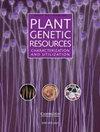印度豆蔻(Elettaria cardamomum, L.)遗传多样性研究为了未来的研究前景
IF 0.7
4区 生物学
Q3 PLANT SCIENCES
Plant Genetic Resources: Characterization and Utilization
Pub Date : 2023-07-17
DOI:10.1017/s1479262123000369
引用次数: 0
摘要
在植物育种中,最重要的先决条件之一是尽可能多地收集具有各种变异性的种质材料。作为全印度香料协调研究项目方案的一部分,在潘帕东帕拉的豆蔻研究站,共有196种小豆蔻种质作为田间基因库保存。印度西高止山脉和斯里兰卡中央高地的热带常绿森林被认为是豆蔻的故乡。豆蔻的面积和产量在喀拉拉邦最大,其次是卡纳塔克邦和泰米尔纳德邦。本文研究并报道了不同种质资源在形态、生物特征和产量上的差异。具有不同形态标记特征的材料,如复合穗型、顶穗型、窄叶型、粉色假茎型、高产潜力的深绿色粗体蒴果型和耐生物胁迫型,在该种质库中进行评价和保存。遗传多样性的评估是开展作物育种活动以培育适合地区和区域的品种的必要前提。对67份豆蔻材料(2016-2018)进行了3年(2016-2018)14个独特性状的遗传多样性评价。几乎所有材料在大多数生物特征和生物胁迫特征上都表现出显著的变异。结果表明,在代表整个西高止山脉热带常绿森林的资料中,小豆蔻存在更大的遗传多样性。本文章由计算机程序翻译,如有差异,请以英文原文为准。
Insights into the genetic diversity of Indian cardamom [Elettaria cardamomum (L.) Maton]: for a future research perspective
One of the most essential prerequisites in plant breeding is to have a maximum collection of germplasm materials with all sorts of variability. As a part of the programme under the All India Coordinated Research Projects on Spices, totally 196 germplasm accessions of small cardamom are being maintained as field gene bank repository at the Cardamom Research Station, Pampadumpara. Tropical evergreen forests of the Indian Western Ghats and Sri Lankan Central Highlands are recognized as the home of cardamom. The area and production of cardamom are maximum in Kerala followed by Karnataka and Tamil Nadu. Variations among the germplasm collections in morphological and biometrical characters as well as for yield have been studied and reported in this paper. Accessions with distinct morphological marker characters, such as compound panicle types, terminal panicle bearing, narrow leaf types, pink pseudostem types, dark green bold capsules with high-yield potential and biotic-stress tolerant types, are being evaluated and conserved in this repository. The assessment of genetic diversity is an essential prerequisite for undertaking crop breeding activities to evolve suitable area and region-specific variety. Sixty-seven cardamom accessions were studied for genetic diversity by evaluating 14 unique characters for 3 years (2016–2018). Almost all accessions have shown significant variability for most of the biometric and biotic stress characters. Results have indicated a greater magnitude of genetic diversity of small cardamom present among accessions representing whole evergreen tropical forest of the Western Ghats.
求助全文
通过发布文献求助,成功后即可免费获取论文全文。
去求助
来源期刊

Plant Genetic Resources: Characterization and Utilization
Agricultural and Biological Sciences-Agronomy and Crop Science
CiteScore
2.80
自引率
0.00%
发文量
29
审稿时长
>12 weeks
期刊介绍:
Plant Genetic Resources is an international journal which provides a forum for describing the application of novel genomic technologies, as well as their integration with established techniques, towards the understanding of the genetic variation captured in both in situ and ex situ collections of crop and non-crop plants; and for the airing of wider issues relevant to plant germplasm conservation and utilisation. We particularly welcome multi-disciplinary approaches that incorporate both a technical and a socio-economic focus. Technical aspects can cover developments in technologies of potential or demonstrated relevance to the analysis of variation and diversity at the phenotypic and genotypic levels.
 求助内容:
求助内容: 应助结果提醒方式:
应助结果提醒方式:


